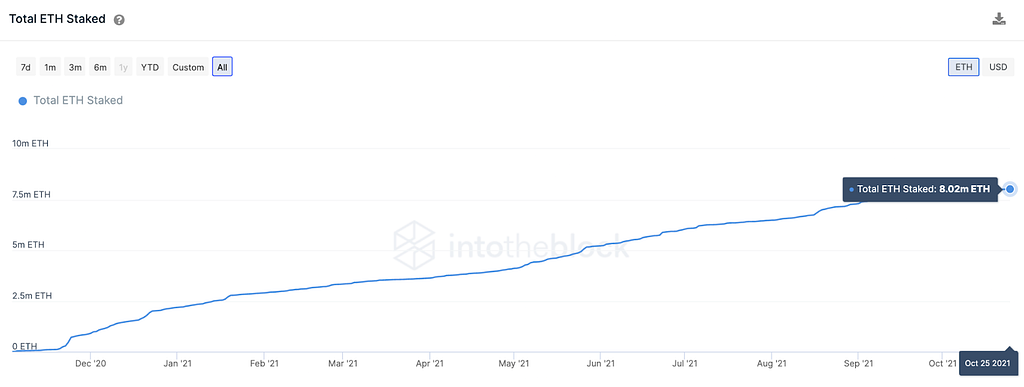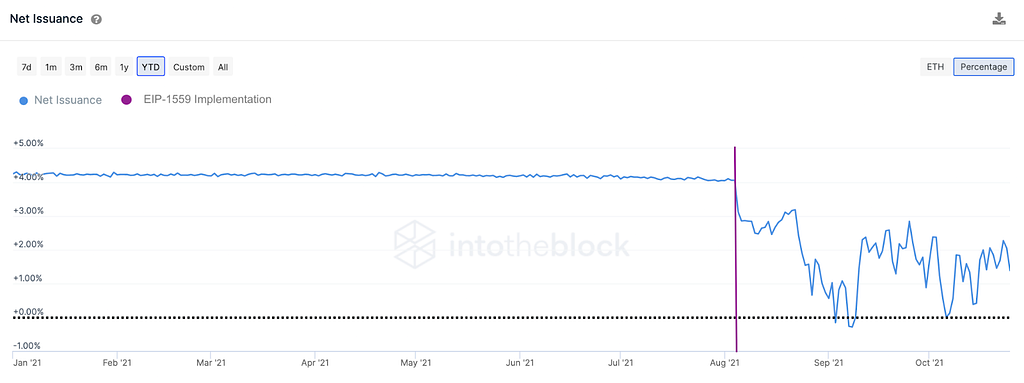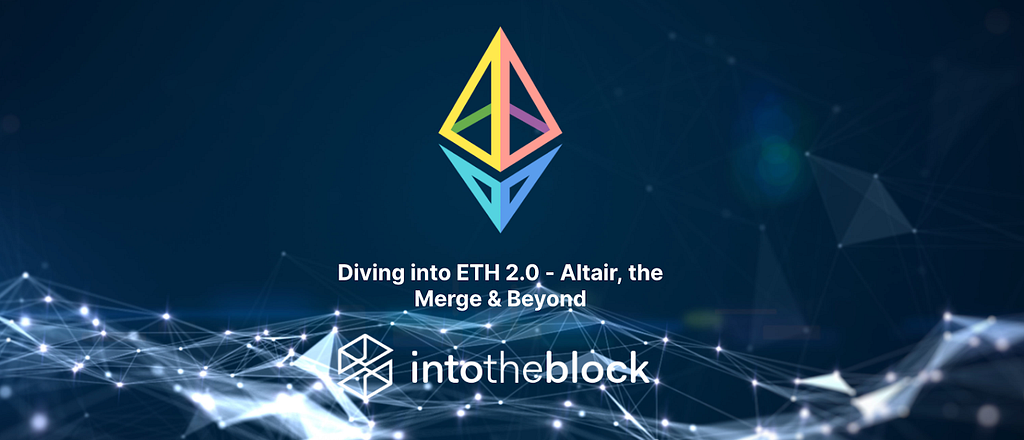Latest news about Bitcoin and all cryptocurrencies. Your daily crypto news habit.
Diving Into Ethereum 2.0 — Part II: Altair, the Merge & Beyond
Analyzing the impact of the Altair upgrade and the upcoming merge on Ether and the Ethereum network.
This piece is the second part of an in-depth analysis of the set of improvements that fall within the Ethereum 2.0 upgrade. In the first part of the Diving into ETH 2.0 series, we cover the upgrades that have already taken place, namely the launch of the proof of stake Beacon chain and the London hard fork where EIP-1559 was implemented. If you’re interested in learning more about those and their impact on Ethereum make sure to give them a read before.
In this piece, we focus on the recent Altair update and how it sets the base for the merge, which is likely to be the largest Ethereum upgrade to date. We discuss the implications of these upgrades both on the Ethereum blockchain and Ether the asset. Overall, these improvements are part of a broader set of steps with the goal of making Ethereum more scalable, environmentally friendly and secure, while simultaneously benefiting ETH and its stakers in the process.
Altair Launch
The Altair upgrade just took place around 11AM (UTC) on October 27, 2021. Regular Ethereum users may not have noticed anything different from the update as it does not impact the blockchain where applications are hosted, but the Beacon Chain instead. This upgrade enhances the Beacon Chain’s decentralization and security properties.
To recap what was described in Part I of this series, the Beacon Chain is Ethereum’s proof of stake blockchain, which has been running in parallel to the proof of work blockchain since December 2020. Currently the Beacon Chain is only processing staking rewards, without any protocols running on top of it to assure the network works as intended. The launch of the Beacon chain has largely been a success, with 100% up-time and recently surpassing 8 million Ether being staked.

This represents over $33 billion worth of Ether being staked, or 6.8% of the total amount of Ether in circulation. Ethereum has reached this feat with over 50,000 validators depositing directly to the staking contract.
The Altair upgrade is the Beacon Chain’s first, and is likely to be the only one prior to the merge with the proof of work chain. In it, Altair has implemented two main improvements: support for light clients and updated measures for dealing with inactive nodes and bad actors.
In its previous state, only full nodes could run on top of the Beacon chain, making it less convenient for those using devices with low GPU or memory capacity. Following the Altair upgrade, light versions of these nodes can now be operated, making it more accessible for anyone to validate transactions taking place on the Beacon Chain. Light clients use full nodes in a trust-minimized way, ensuring that the blockchain can be authenticated in a decentralized manner.
Moreover, Altair executed a change in the measures punishing inactive nodes and bad actors with the aim of improving the network’s security. Fully inactive nodes now stand to lose as much as 15% of their balance, up from 12% prior to Altair, further disincentivizing inactivity. Similarly, the parameters used for “slashing” bad actors are now more severe. The minimum slashing penalty has doubled to 0.5 ETH, with nodes acting against consensus risking 1/64th of their holdings for every “slashable” offense (as opposed to 1/128 previously). The severity of slashing fees are now also subject to a multiplier of 2 based on the proportion of validators being slashed. In other words, if 10% of validators are committing slashable actions, the corresponding penalty would be 20%. Ultimately, this penalizes bad actors to a larger extent and even more if a high percentage of validators are attempting to attack the network. Since validators have a stake in the network, they are incentivized to act in the best interest of the blockchain in order to avoid financial losses and be compensated instead.
Finally, Altair also serves as a way to assure that the Beacon Chain can be upgraded without any issues. Through these improvements, as well as a few minor bug fixes, Altair is gearing up Ethereum towards its largest, most-anticipated update.
The Merge & Beyond
Ethereum’s transition to proof of stake has been proposed by Vitalik since 2014. Not only does this lead to negligible resource consumption, it also aims to improve Ethereum’s security and scalability. The so-called merge will bring this vision forth by migrating applications running on the current proof of work blockchain into an executable version of the Beacon Chain.
The merge has already been successfully tested for the first time in the Amphora workshop and will continue to be examined in the upcoming months. Based on the most recent Ethereum core developers meeting, deploying the merge in March 2022 was seen as “optimistic”, with Q2 being a more realistic timeline.
The implementation of the merge will not only affect the applications running on Ethereum, but also benefit Ether holders and stakers. The merge does so by simultaneously reducing ETH issuance and increasing stakers’ rewards. Currently, Ether’s supply is growing by approximately 2% per year with a circulating supply of roughly 118 million ETH.

Following the merge, ETH’s issuance is expected to drop by 90%, with a supply peak around 120 million and slow decrease henceforth. This ties back in with EIP-1559, which introduced the basefee and effectively removes Ether from circulation as the Ethereum blockchain becomes more used. The transition to Ether becoming deflationary is anticipated to create upwards price pressure as its supply will decrease as demand increases.
Additionally, since Ethereum will no longer rely on miners, the remaining portion of fees not burned will go to validators staking their ETH. This will result in significantly higher staking APY rewards. These returns vary based on the amount of Ether staked, the fees being processed and percentage of these being burned. Based on IntoTheBlock’s calculations, staking rewards are likely to double from 5% currently to 10% to 12% following the merge.
These projections are based on the growth of the three key parameters in the past 7, 30 and 90 days, using the calculations from Ethereum Foundations researcher Justin Drake. If you’re keen on looking into these numbers and playing with the parameters, feel free to make a copy of this document.
Not only are higher staking APYs great for validators, they also improve the network’s security. This is the case as greater returns incentivize more ETH to be staked, and having more value staked make it more expensive to anyone to attempt to attack the network since they would need larger holdings to influence consensus. Furthermore, the slashing penalties increased through the Altair upgrade lead bad actors to financial losses if they act against the network’s best interest. Ultimately, this improves upon Ethereum’s security while aligning the interests of network participants.
Conclusion
Ethereum is an ever-evolving infrastructure for decentralized applications. As the demand for a myriad of use cases blossoms, Ethereum has envisioned a path towards a more secure, scalable and environmentally friendly network. Through the Altair upgrade, Ethereum sets the base for this vision, enabling the upcoming merge of the proof of work chain and the Beacon Chain. Finally, these are expected to benefit Ether holders and stakers by making it deflationary while offering higher returns to validators.
One thing many may have noticed is not mentioned in this piece is the scalability part. While this does not fit directly into the Ethereum 2.0 upgrades discussed, it is currently being addressed by layer 2 solutions and is the main aim of the implementation of sharded chains. Layer 2 scaling platforms such as Arbitrum and Starkware have already reached over $4 billion in total value locked, while reducing Ethereum transaction fees by 90% and increasing throughput. Meanwhile, sharding is the final piece for Ethereum 2.0, set to improve scalability by 100x through the implementation of multiple interconnected chains. Currently, sharding is expected to launch in late 2022 or early 2023.
Diving Into Ethereum 2.0 — Part II: Altair, the Merge & Beyond was originally published in IntoTheBlock on Medium, where people are continuing the conversation by highlighting and responding to this story.
Disclaimer
The views and opinions expressed in this article are solely those of the authors and do not reflect the views of Bitcoin Insider. Every investment and trading move involves risk - this is especially true for cryptocurrencies given their volatility. We strongly advise our readers to conduct their own research when making a decision.

